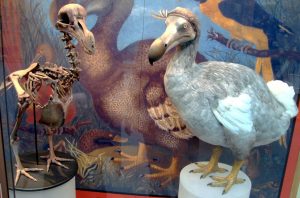Dodo
Raphus cucullatus
- Dodos were flightless birds, related to pigeons, which is said to be evolved on the island of Mauritius 8 million years ago.
- The dodo’s ancestors is supposed to have arrived on the island, eventually evolving int
 o giants and losing their ability to fly.
o giants and losing their ability to fly. - These birds were first seen by Portuguese sailors about 1507, Dutch sailors probably first encountered the bird in 1598, first published record of the bird dates to 1599 and was extinct by 1681.
- The dodo is frequently cited as one of the most well-known examples of human-induced extinction.
- The dodo was bigger than a turkey and weighed about 23 kg.
- It had blue-gray plumage, a big head, a blackish bill with reddish sheath forming the hooked tip, small useless wings, stout yellow legs, and a tuft of curly feathers high on its rear end.
- All that remains of the dodo is a head and foot at Oxford, a foot in the British Museum, a head in Copenhagen, and skeletons, more or less complete, in various museums of Europe, the United States, and Mauritius.
- The tubby bird depicted in modern reconstructions is based on illustrations probably drawn from overfed captive birds or poorly-stuffed dead specimens.
- In the wild the dodo was supposed to be a sturdy, robust bird, with thick leg bones and a broad pelvis.
- It had sizable kneecaps, that were maneuverable, strong, and supportive, ideal for the bird to move quickly in its rocky, densely forested home.
- Analyzing dodo’s wing scientist found pronounced bumps, ridges, and depressions where the muscles would have attached to the bones, suggesting that the birds used their wings for balance.
- Also the bird is assumed to have an enhanced sense of smell, an adaptation that could have helped it sniff out ripe fruit and other food in the island’s thick vegetation.
- The ratio of Dodo’s brain volume to its total body mass was similar to that of modern pigeons, which enable the bird for visual discrimination and navigation.
- So it could be concluded that dodo was not maladapted, or “an evolutionary loser,”
Causes for extinction
- Exactly the causes of the dodo’s demise are unclear, there’s little evidence that they were hunted to extinction.
- Excavations of Fort which housed Dutch settlers between 1638 and 1710, suggests that the settlers fed mainly on livestock they brought to the island, as well as local fish.
- Journals from Dutch sailors do reveal that dodos were eaten at least occasionally.
- Insights about the bird and its habitat are emerging from the works of paleontologist, paleoecologists and geologists.
- It is assumed that years ago, Mauritius was a tough and turbulent place for wild animals to live as it was volcanically active and regularly struck by cyclones, which could cause severe food shortages.
- Extreme climatic shifts led to long periods of severe drought, fueling wildfires and mass animal die-offs.
- One such megadrought struck 4,200 years ago, a shallow freshwater lake in island’s Mare aux Songes region began drying up.
- Thirsty animals crowded around the shrinking water surface, it is supposed that, they left nutrient-rich droppings that fed the growth of toxic bacteria.
- Many thousands of animals , from at least 22 different species, perished as the lake transformed into a muddy, poisonous swamp.
- It is supposed that the animals died there because they drank the water contaminated with toxic cyanobacteria or because they couldn’t drink enough.
- Dodo’s extinction was indirectly caused, by introducing a variety of non-native species, including pigs, goats, deer, monkeys, and rats.
- Some of these creatures, particularly pigs, would have eaten dodo eggs and chicks, while others competed with dodos for food.
